How to Maintain a Sourdough Starter Without Feedings or Discards
Learn how I have been maintaining an easy sourdough starter without daily feedings or discards for decades and still bake delicious breads!
Are you tired of daily feedings or discards?
Are you intimidated by such a commitment to maintaining a sourdough starter?
The good news is there is another way!
In this blog post, I am sharing how I have been maintaining my sourdough starter without feeding it or discarding any. I am still baking delicious breads, such as this hearty European-style whole grain bread or a classic artisan-style no-knead bread. I even make sourdough pasta with this starter. This method is perfect for any home baker who does not use their sourdough starter on a daily basis.
This post contains affiliate links, which means I make a small commission at no extra cost to you. You can read my full disclosure.
My experience with sourdough
I basically grew up with sourdough. My mom would bake a loaf of sourdough bread about once a week (or more as we got older and ate more). She actually learned how to make her own sourdough starter and bake sourdough bread from my grandmother who had learned it from her mother and so on. I don’t know how many generations this goes back but you get the drift.
My mom used the no-feedings no discard method.
Fun fact: up until a few years ago, I didn’t even know that there was another sourdough method that involves daily feedings and discards. I really thought that everyone was using a sourdough method similar to ours.
At this point, I have two sourdough starters: one for my white artisan-style bread and another one with whole wheat flour for my German sourdough bread. They get used at different intervals.
And just if you’re wondering, no, I have not named them.
Need more help?
Check out my
Super Simple Sourdough Course!
Why use the no discard no feeding method for your sourdough starter?
You might be perfectly happy with your current sourdough method. But then I guess you wouldn’t be reading this article.
- So, if you bake twice a week or less, this method is perfect for you. Maybe you bake very infrequently or just don’t want to commit to this daily maintenance. Also, you will be using less flour for your feedings. These days, when everything seems to be getting more expensive, this method is a great way to save some money. You also won’t end up with too much sourdough starter that you don’t know what to do with.
- Or you want to take a break, let’s say because you’re going on vacation. That is probably why you have read this far.
Well, keep reading because you will love this easy way!
How to do the no feedings and no discards sourdough starter method
Since there is a cycle, I am just starting at the point where you have your active starter on the counter. If you don’t already have your own starter, you can read here how I make a new one without feeding or discards, either.
- Use the starter for your recipe but be sure to keep a small amount of starter in the jar (about 1/8 to ¼ cup). However, this does not have to be a very exact amount!
- Now you add a lot of fresh flour to it. It has to be so much flour that your leftover starter becomes very dry and almost not manageable. For best results, it’s also great to have extra flour underneath and on top of the starter. I like to press it down with my fork or spoon.
- Put a lid on your mason jar or other non-reactive container and place it in the refrigerator. Done! It’s as simple as that.
- A picture often says more than a thousand words. That is why I have created this free download for you:
When you want to bake with your sourdough starter
As you know, baking with sourdough requires a bit more forethought than baking with commercial yeast or baking powder. With this no feed no discard method, you need to add just a little bit more time.
- Let’s say I would like to bake on Wednesday, I take my starter out of the fridge Tuesday evening before I head to bed. By this time, I have this whole routine down without having to think about it much.
- Simply add about ¼ -½ cup of filtered or bottled water to your dry starter and stir it well. You can use warm water if you like, especially if you have a very cold kitchen. When it was sitting in the refrigerator it essentially became inactive. Now we are re-activating it.
- By the next day, you should have a ripe, healthy starter that you can use in your favorite recipe. You should be seeing lots of bubbles in your sourdough starter. If you are skeptical about your starter, you can always use the float test.
- Sometimes, I like to create a hybrid method: which means I will activate my starter and let it reactivate overnight. The next day, I add equal parts of flour and water to it. That way, I will have I will then bake the following day. This step is completely optional, though!
Helpful Tips:
- If you are not certain about your sourdough starter, you can always add a little bit of instant yeast to your recipes. Don’t feel like you are cheating when you do that! Yeast is a natural part of the sourdough cultures next to lactic acid bacteria.
- Especially if you are using your sourdough starter for bread dough, you can use rye flour instead of wheat flour. The former makes a particularly active sourdough starter.
Don’t be afraid of experimenting! And never give up!
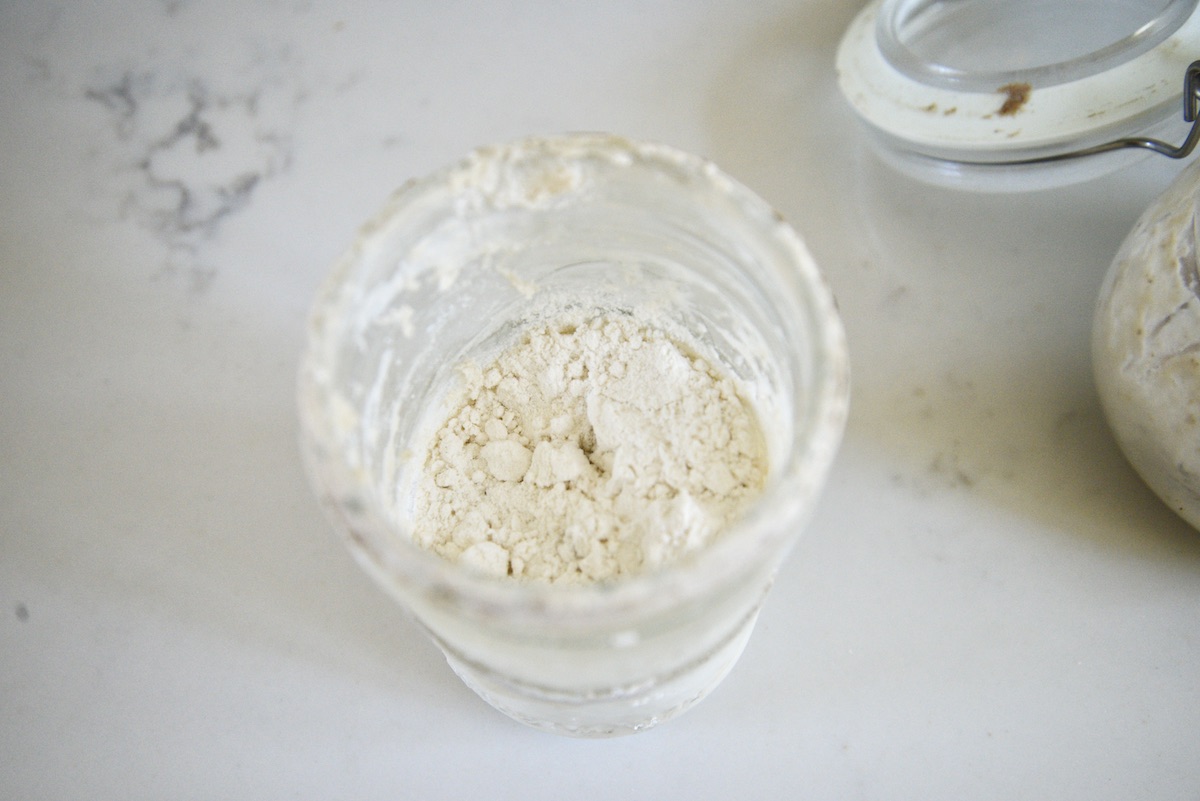
What happens next?
When you are ready to bake or use your sourdough starter, simply remember to keep a bit left for your next batch. Now, you can go back to the top and repeat the whole process all over again.
Sometimes a picture says more than a thousand words. Therefore, I have created this cheat sheet of the life cycle of your sourdough starter with my method.
I also have a recipe video that shows you exactly how to use this no discards sourdough method in real life.
Also, I have an entire blog post on how to prevent mold on your sourdough starter that you might like to read.
How long can you keep the sourdough starter in the refrigerator?
My short answer: I have kept it there for 6 weeks and still used it successfully.
Here’s my longer answer: Having had my sourdough starter sit in the fridge for 6 weeks was pushing it a little. It had a strong, pungent, very sour smell. At that point, I definitely recommend taking it out 2 to 3 days before you’d like to use it and doing 2-3 feedings with discards. While I don’t recommend letting your starter sit in the fridge that long on a regular basis, I baked with it without any problems.
Usually, I keep my whole-grain sourdough starter in the refrigerator for about 10 days or so. Even keeping it for 2-3 weeks is no problem. However, people have told me that they had “forgotten” their sourdough starter in the back of their fridge for over 6 months, and was still fine.
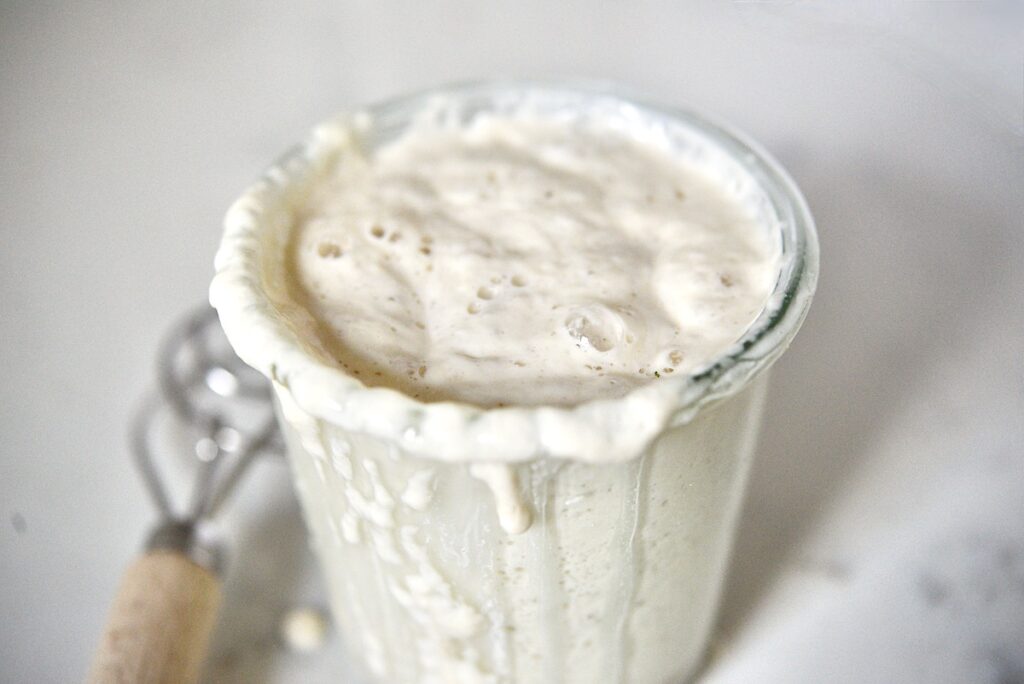
Which sourdough method is best for YOU?
Now that you know how easy it is to keep a no discard sourdough starter, you can also decide which method works best for you. As I mentioned above, I sometimes add a feeding and a discard to my starters to give them a boost or if I want to bake more than one bread. I like to call this my “hybrid method”.
That might be a perfect option for you. But once again, if you’re baking and using your sourdough starter on a daily basis, you’ll want to stick with keeping it on your counter and taking care of it there.
Just know that you can easily switch back and forth between whatever method you have been using and my sourdough method!
The pros of the no discard sourdough starter method:
- you will waste little to no flour
- no more discarded starter
- it’s the easiest way for beginners and first-time bakers
- you don’t need a kitchen scale (even though I do recommend you have one!)
- it is the best way for baking less frequently
The cons of the no discard sourdough starter method:
- can be challenging for people who want exact measurements and instructions
- not necessary for people who use their discard sourdough starter every day
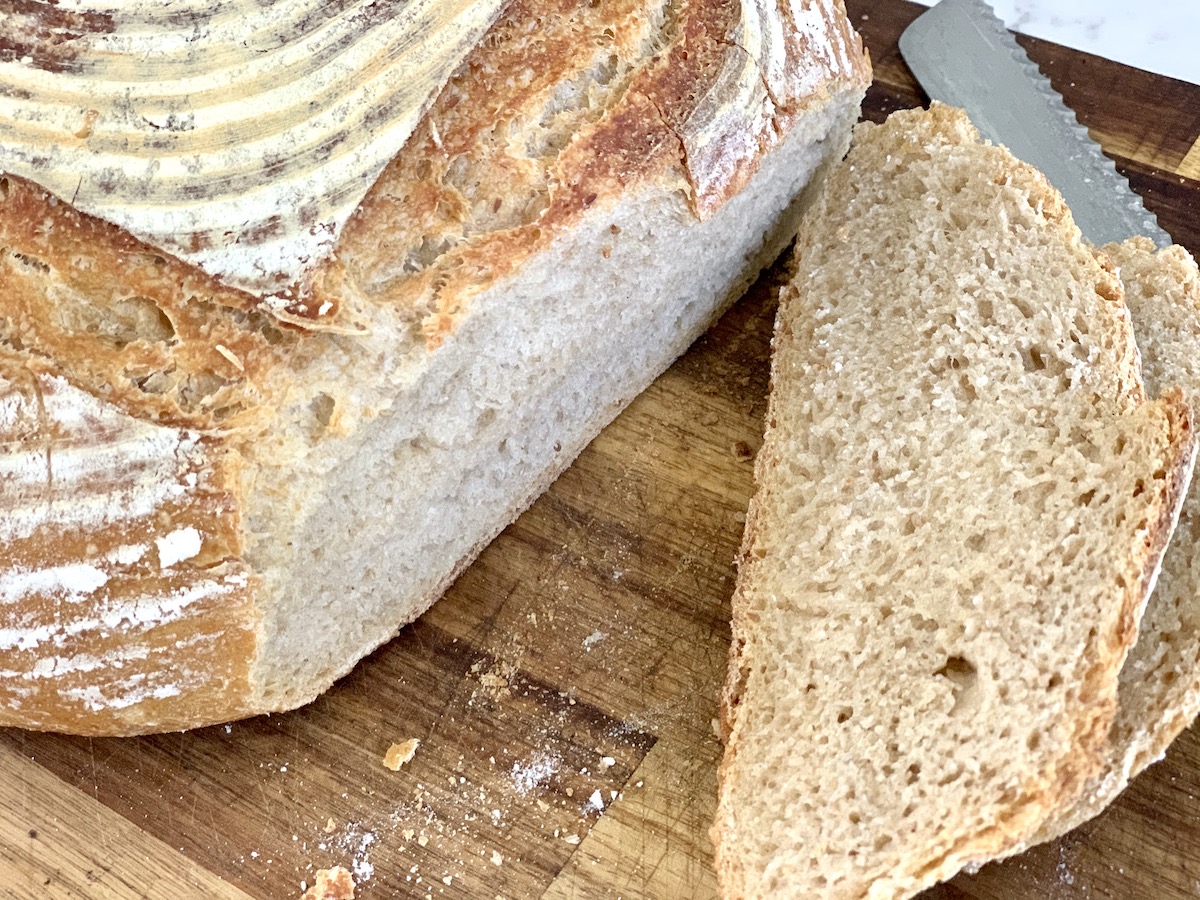
Frequently Asked Questions:
I have kept it in the refrigerator for 6 months. If you keep it longer, it might get more pungent. In that case, you could spoon out 1 TBSP of dry starter, add some water and flour to it and leave it on the counter for 12-24 hours.
Absolutely! You can even switch back and forth between a discard/feeding method on your counter to this dry starter method in the refrigerator.
You can. However, then you need to discard some and feed it every two weeks. With my method you don’t need to do anything with it at all.
Yes, my sourdough method works regardless of the flour you use. You can even maintain your gluten-free sourdough starter with this method.
Then you might like to read my entire article on how to manage the sourness of your sourdough.
Watch my Video Tutorial:
Ready to bake? Here are some sourdough recipes you might enjoy:
German Whole-Grain Sourdough Bread
Life-Changing Sourdough Loaf of Bread
Pumpkin Sourdough Bread Pudding
Easy Sourdough: No Feeding, No Discards
Ingredients
- ¼ cup ripe sourdough starter
- 1 cup flour
Instructions
- Pinch off about ¼ cup of sourdough and place in a glass jar or non-reactive container.
- With a fork work in 1 cup of flour or more until the dough is very stiff, dry, and crumbly. Heap some more flour on top.
- Place a lid on the jar and place the sourdough starter in the refrigerator.
- The evening before you want to bake, take the jar out of the refrigerator.
- Add some filtered or distilled water to it. With a fork, stir the water into the sourdough starter until you have a thick consistency. Don't worry about any remaining clump.
- Let this mixture sit out at room temperature until the next morning.
- Use your active sourdough starter according to the recipe.
- Don't forget to keep back ¼ cup of starter to repeat the process.
Notes
- if you are not sure your sourdough starter is active enough for baking you can always add a pinch of commercial yeast
- or you can add one cycle of discard/feeding to make it more active
Video
Nutrition
Do you have any questions or comments for me? Let me know below!
Pin For Later:
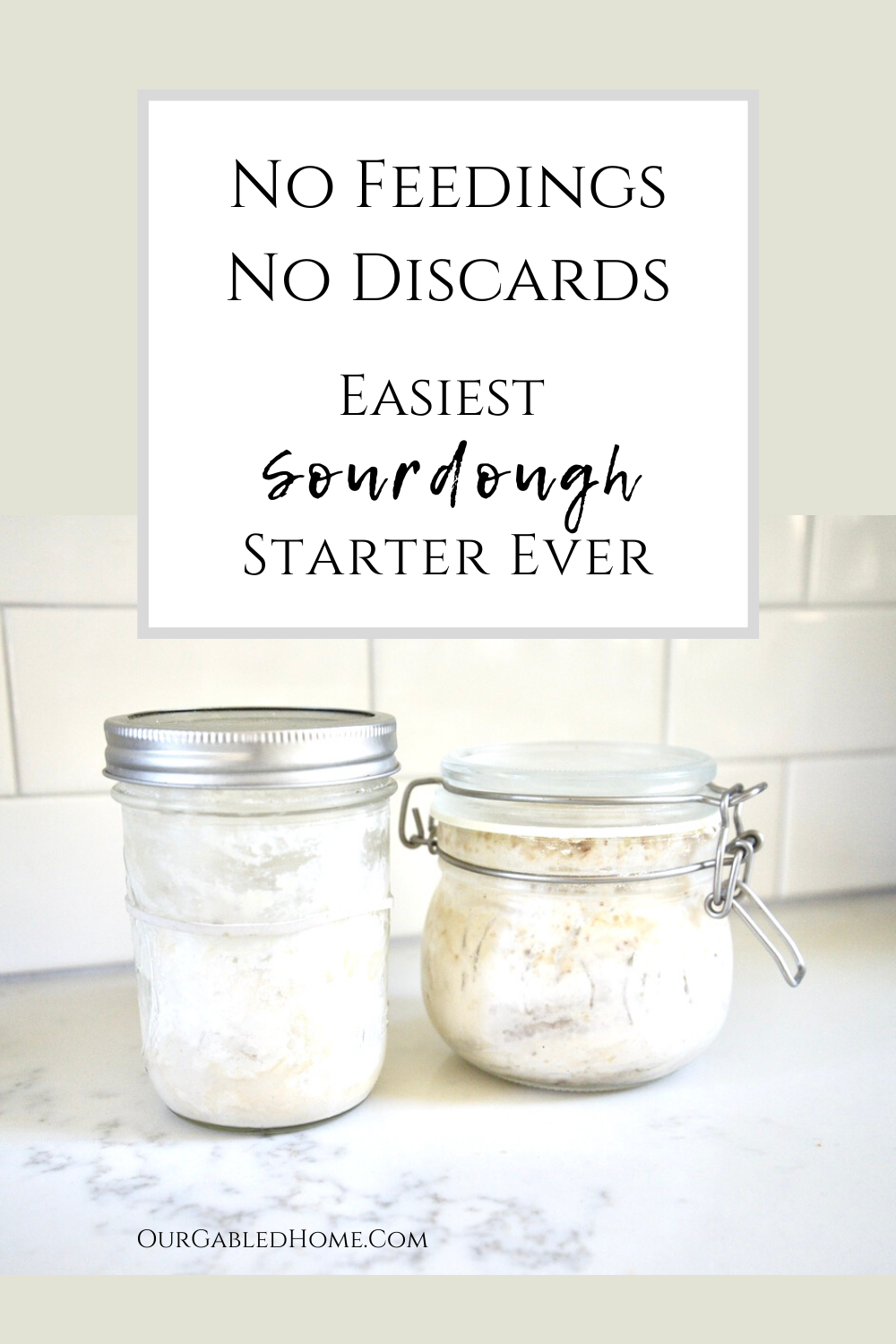

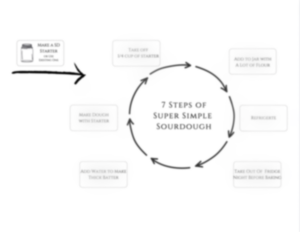

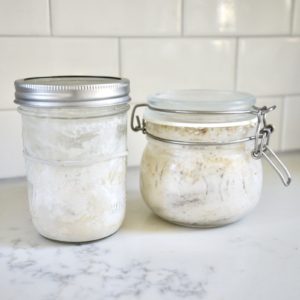
You mentioned using rye flour to jump start it. If I am using a cup of flour, can I add a 1/2 cup unbleached organic flour and 1/2 cup of rye flour and mix them together to make my starter?
Yes, that should work great ~ Anja
I love your recipes and sourdough tips!! I’m ready to make my sourdough starter. Since I make only whole wheat bread, should I use white flour or rye flour to make the starter? I bake 2 loaves of whole wheat molasses multi-seed bread about once a month. Will sourdough starter last that long in the fridge? Any tips on how to convert my recipe from using 1 Tblsp of yeast to sourdough starter? The recipe calls for 3.5 cups of whole wheat flour and 3.5 cups of bread flour plus 1.5 cups milk, 4 Tblsp butter, 1 Tblsp salt, 1/2 cup molasses and 2 cups of seeds.
It really doesn’t matter what flour you use for your starter and it doesn’t have to be the same as what you’ll be using for your bread. I have another blog post about converting yeast recipes to sourdough: https://ourgabledhome.com/how-to-convert-any-recipe-to-sourdough-with-conversions/ ~ Anja
Thank you, Anja! For us infrequent bakers, will your starter recipe last 4-6 weeks in the fridge?
Yes, it will easily last 4-6 weeks in the fridge ~ Anja
After adding water and letting it sit overnight should it double in size? Mine didn’t. It had liquid on top so I added more flour. It’s just sitting in my oven with the light on. Super bubbly but not growing. The day is wasted so I won’t be able to use it now for another couple days.
It may not always double but if it’s bubbly and active you can absolutely use it. You can also put it in the fridge for two days and bring it to room temperature before baking.
Hi, I’ve always kept my starter in the fridge and fed it only when I needed to use it. Now I’m baking multiple loaves almost daily. The sour flavor has disappeared and my bread lacks flavor. How do I maintain a starter while keeping the sourness and baking daily? Thank you, Jacqui
You might like to read this post: https://ourgabledhome.com/17-ways-to-make-your-sourdough-less-or-more-sour/ Hope this helps ~ Anja
Hey Anja. I just had someone give me a Sourdough Bread Starter and I am totally lost. I do not believe it was in a Refrigerator at all. I have NEVER done anything even remotely with a starter and know nothing about it. I do not bake bread very much at all but what can I do to keep this starter until I can bake some bread? So I guess my question would be: Can I take this starter I have, mix in flour until it is almost crumbly and put in refrigerator until I am able to bake some….then…..take a 1/4 cup like your recipe talks about putting into another clean jar and add enough water to make it pancake consistence and use it for my baking but leave the rest of the starter in the refrigerator as is until I need to do another loaf of bread. Sorry for the lengthy message but I am totally lost on this! Any help sure would be appreciated!!!!!
Yes, you perfectly can. I may have shown this in this video: https://www.youtube.com/watch?v=mFsmW5BlqbY&t=534s Hope this helps ~ Anja
Hi when storing the dry starter in the refrigerator do I keep the lid on tight? Currently I’m keeping it in a mason jar with screw on type lid. When I opened it to use it there was some air pressure build up. Is that ok or should I not tighten my lid all the way?
I keep it in the fridge with a tight lid to prevent other things potentially swirling around in there from interfering with my SD starter. If you have some gas build-up that means that your starter has been active. I would add a lot more flour to it. Hope this helps ~ Anja
I just made your starter and I’m so looking forward to making my first sourdough bread! Thank you so much for the easiest way ever!!
Yay! So glad you enjoy my SD method! Happy baking ~ Anja
I love this method! I hate to waste and had gotten down to 1T per day – still too much!
Question: i get some lumps in my starter that stay lumpy in the bread dough and once formed a hard lump after baked. Has this happened to others? Any suggestions?
Hi Susan, I often get lumps, too. They are mostly an aesthetic issue. You can try to break them up more diligently with a fork and or start reactivating your starter a few hours earlier so it has more time to soak up all the water. Hope this helps ~ Anja
I am new to your blog and have a sourdough starter that is a few years old. I would love too also have a whole grain starter like you mentioned but couldn’t find the directions on how to make it. Would I start with some of my regular starter and add whole grain flours for a few feedings or is there a better way. Thanks so much, I am really enjoying your videos!
Hi Sherry, this is what I recommend: bake a whole grain bread with all of your white sourdough starter. Let is rise/ferment. Before you transfer it to the loaf pan, take out about ¼ cup of dough. Place it in a jar with a lot of flour and put it in the fridge. That will be your (next) whole grain SD starter. Hope this helps ~ Anja
These are amazing sourdough starter tips! I am in the process of starting my own so I will be checking back to this post!
Thank you so much, Jamie! Sourdough can be so easy and no-fuzz! I hope you’re getting your SD off to a good start ~ Anja
Loved reading this. Your steps and thorough instructions make this so much easier than making traditional sourdough. Thanks for sharing.
Yay! I am so glad you like my sourdough method ~ Anja
This is so helpful! I had never heard of doing this before. Thanks for sharing!
Yay! I am so glad you found this helpful! Happy sourdoughing ~ Anja
Super great info! I had no idea about this method!
Wow, this is amazing! I have been feeding my sourdough starter once a week (or whenever I need it) for about two years now, but this method is so much easier! Thanks for sharing!
Yes! I am so glad you like this easy sourdough method ~ Anja
How do I make my sourdough bread more ‘sour’?
Thank you
You can use less SD starter for the recipe, decrease the amount of salt, and/or increase fermentation time ~ Anja
Definitely going to try this! Could you tell me what the difference in baking is when you do the hybrid way instead of just using the starter you pulled out the night before?
Hoping that this is the answer you’re looking for: there should not be a difference. Let me know if this is not what you were looking for ~ Anja
I’m just curious, If there is no difference, why would you go through the extra step?
That is a good question. Have you experimented with both methods?
This is great! It makes the entire process easier! Thank you so much for sharing!
I love your sourdough no feed method! I am so happy I found it! I am making my first sourdough bread with your method. It is perfect for me, because I cannot bake every day with the schedule I have. One question, after using some of the starter for the bread, and then adding the flour so that it can be refrigerated, is it good for another two weeks or so? In other words, if I keep using the starter before it expires, is it good for as long as I keep using some, and then mixing it with flour and putting it back in the fridge? That keeps it active indefinitely?
Can you use any kind of sourdough recipe with this method? I have already started one from another recipe. Thank you!
Yes! You can use ANY sourdough starter from any recipe with this method! Happy sourdoughing ~ Anja
It’s day six and my starter is thin should I add more flour or just use it
it is bubbly
See my response to your other comment 🙂
Do you put the lid on air tight with this method? Or just set it on loosely? Thanks!
It really doesn’t matter so much. I just try to keep any critters out, so a loose-fitting lid or some cloth is fine. Hope this helps ~ Anja
After DAY6 my starter is bubbly but it is thin should I add more flour or just leave it and use it
Hey there, I like my sourdough starter to have the consistency of pancake batter. You can add some more flour if you like, it won’t hurt it, it might just take another day to get all bubbly again. But it sounds like you created a perfectly ripe starter!!!
Hello!
First of all thank you for the article!
It’s since 2015 that I use sourdough starter and I’ve never heard about this method of conservation.
It works perfectly and helps to keep the starter always in perfect conditions.
I’m very grateful to you.
Best
Rik
Hi Rick, I am so glad to hear that my method is working well for you! Thank you so much for sharing and happy sourdoughing ~ Anja
Hi Anja, I tried making the starter using homemade buttermilk(1 cup milk with 1 tbsp lemon juice). After 12 hours I saw bubbles in my starter and a layer of liquid at the bottom of the container. Is this meant to be like that and should I be stirring the liquid back into the starter?
Hi Joyce, normally I recommend using cultured buttermilk (vs creating curdling with lemon juice) but it sounds like you might have a good starter on the way. I have never seen the liquid on the bottom but I would just stir it back in and keep watching it. Hope this helps ~ Anja
I love this sourdough method. I find it easy, and it comes out perfect every time. Thanks for this recipe.
Yes! I mean who’s got time to babysit their sourdough starter every day, right? Anja
I’m new to sour dough and just received my first starter a couple of months ago. I came across your video and am wondering if I don’t use my starter in the fridge for a while (kept like yours) do I still feed it every so often? If so, how?
Hi Allison, you can use any SD starter with my method. Just add a lot of flour, put a lid on, and place it in the refrigerator. If you haven’t used it in 6 weeks, you might like to take it out, add some water, let it come back to life, use some, and repeat the previous steps. Hope this helps ~ Anja
How do you make the initial starter. I must have missed that. I’m excited to try this. I have done this and feeding daily is not what want to do. Have you shared recipe for you bread.
Hi there, I do have a blog post (with a link to the video) on how to make a starter: https://www.ourgabledhome.com/how-to-make-your-own-sourdough-starter/ And I have an Artisan-style sourdough bread recipe: https://www.ourgabledhome.com/easy-no-knead-sourdough-bread/ as well as a European-style sourdough bread recipe: https://www.ourgabledhome.com/sourdough-bread-from-scratch/ Hope this helps 💛 ~ Anja
Hi Anja, first I really love your video and thank you for sharing! I tried to do the beginning sourdough starter this week with the buttermilk and rye flour. I placed the starter in my kitchen windowsill. On day 4 I went to check out how it was doing and there was a ring of mold around the mason jar above the starter. I dumped the starter in the garbage and noticed that my starter was bubbly. I was so sad to have dumped it… Has this ever happened to you and if so do you have any recommendations? Should I have just wiped off the mold? To disclose I live in Nevada and it has been about 32 – 50 degrees. I turn my heat down at night so that my home gets to a low of 63 degrees or so. I have placed the starter on a coffee cup warmer at night so that the starter stays closer to the 68 degrees. I have to wonder if this caused the mold? We are very dry here in Nevada so it was really weird that, that happened. Thank you! Laurie
Hi Laurie, thank you for reaching out! Mold on a sourdough starter jar can happen for any number of reasons but most likely because the jar may not have been very clean and/or had soap residue on it. If there’s only a little bit, you can wipe it off. I don’t think 68 degrees is too warm for your starter. My best recommendation is to start over again and see what happens. Hope this helps and let me know if you have more questions 💛 ~ Anja
Good morning! Thank you for writing me back about the mold! I did start a new one and I it seems to be successful!! I have one more question please… I want to make the no knead sourdough bread as you shared in your video. In your video you put all of your starter into the bread with no remaining for a next loaf. My question is, should I increase the starter so that I will have a 1/4 cup or so left over after using 1 cup for the bread? I am betting the answer is yes but I would like to clarify. When you dumped out half I don’t understand why? Thank you Anja!
I am so glad you were able to use the butter mold correctly!! As for the no-knead bread, I may have had some extra starter somewhere for the video. Ideally, you want about 1 cup of sourdough starter for the bread and about ¼ c or so that goes back in the fridge. So, yes, make sure you have enough. However, since the recipe also calls for yeast and barley malt, it is not super critical that you have exactly 1 cup of starter. You can probably get away with ¾ c and let it rise a tad longer. I hope this helps ~ Anja
Thank Anja!
Hi. I’ve had my starter in the fridge for a little over a week. It’s thick but pourable with a lot of bubbles. I took out a cup to sit out overnight to use tomorrow. Should I add more flour to it?
Hi Diane, I would thicken your sourdough starter even more when you keep it in the fridge. I always add so much flour that it’s very hard and dry and then I add some more. Hope this helps but let me know if you have more questions ~ Anja
Hi Anja,
I have enjoyed your YouTube clips about sour dough starters and bread making!
My challenge is that I have started the sour dough starter twice. Each time about day 3or 4 mold starts grown around the top edge and I smell mold even after removing it. Now sure how to proceed with the starter now. Can you advise? Thank you, Shirley
Hi Shirley, thank you so much for reaching out. I personally have not had any issues with mold but I hear it does happen. There could be contamination in the jar from soap residue, your tap water, or mold spores in the air. Here’s an article you might like to read: https://www.theclevercarrot.com/2018/03/troubleshooting-your-sourdough-starter/comment-page-1/ If this doesn’t help, I would suggest buying a starter and seeing if that makes a difference. Here’s one from a reputable company: https://amzn.to/39Wtaf7 Hope this helps and let me know if you’ve been having success ~ Anja
Thank you so much Anja.Will look at your suggestions and keep trying,Shirley
Dear Anja,
This time, I took out starter out Sunday evening and started stirring at 9 pm. Then I checked it at 7 am. It had lots of small bubbles on top and a few puffy places. I did the float test and it floated! So 10 hours after adding the water and stirring it up it was ready. I did not want to wait longer cause then it might go flat on me. It did work last time when flat and de-bubbled etc. but I liked the idea of using it when all ready to go. SO, I got the flours out and started baking. I love this system and thank you again for sharing it.
I’d love your wholegrain sourdough recipe if you can share it. I am using half white high protein and half spelt and oat in mine.
Thanks! Susan
Hi Susan, it sounds like you got it! It’s always nice to hear about people’s sourdough successes!! Here’s a recipe that would be perfect for white flour/spelt/oat: https://www.ourgabledhome.com/sourdough-bread-from-scratch/ Have fun baking ~ Anja
Thank you so much! I have a grain grinder so I am all set. Yum!
Dear Anja,
Another question: after you have added the water and stirred up your starter, how long does it take to be ready for baking? How do you decide that your starter is ready, and after about how many hours is that? I take out in evening and stir up etc. so I can bake in the morning.
Thanks again!
Susan
Hi Susan, I usually take the starter out in the evening, add the water, stir it up, and let it sit overnight. Then I make the bread in the morning and bake in the evening. I have been doing this for decades. Usually, I gauge the bread once it’s in the loaf pan. Sometimes, it rises so fast, I bake it in the afternoon and sometimes, I need to let it sit longer in which case I bake in the evening. Hope this helps! Have fun, Anja
So what is the actual recipe? Did I miss something?
It’s in the post – let me know if you can’t see it!
Dear Anja,
This time, I took out starter out Sunday evening and started stirring at 9 pm. Then I checked it at 7 am. It had lots of small bubbles on top and a few puffy places. I did the float test and it floated! So 10 hours after adding the water and stirring it up it was ready. I did not want to wait longer cause then it might go flat on me. It did work last time when flat and de-bubbled etc. but I liked the idea of using it when all ready to go. SO, I got the flours out and started baking. I love this system and thank you again for sharing it.
I’d love your wholegrain sourdough recipe if you can share it. I am using half white high protein and half spelt and oat in mine.
Thanks! Susan
Hi, i wonder what the difference is between this method and the “scrape method” that i use is? I leave just the scrapes in the jar, put it in the fridge and prior to baking i feed it with the amount needed. Then i just put the scrapes back again. By feeding it with a lot of flour as you do, does this have any other effect?
Thank you for your comment and question. Since I am not that familiar with the “scrape method”, I can’t say for sure. It sounds similar though. I add all this flour to slow down the starter as it waits in the fridge for me to do something with it. Hope this helps!
Hello Anja, I was so happy to find this system of no feeding and no discards! I have one bread baked with it and a second one is rising now. I have some questions:
1. After adding water and smushing and stirring with a fork, I find there are still small lumps left. Is OK?
2. Do you keep a tight lid on your starter in the frig or loose?
3. Do you keep a tight lid on your starter on the counter top or loose?
4. How long does it normally take for the starter to be bubbly and active? I ask because both times now let starter do its thing for 11-12 hours on counter top in 68 degree house. At about 10-11 hours there were some patches of small bubbles and some swelling. So I let it go longer but there was not much change. I di the float test and it sank! I used it anyway and bread rose fine. I have white and rye in the starter. Any tips? It did not look all bubbly like yours.
THANK YOU SO MUCH! and HAPPY THANKSGIVING!
Susan
Hi Susan, I am so glad you like my sourdough method! Now for your questions:
1. Lumps are ok. I like to break up bigger ones but don’t worry about the smaller ones.
2. I do but I don’t think it’s necessary unless you keep it right next to your sauerkraut or totally different ferment.
3. Same thing here as #2
4. I often don’t get a very bubbly sourdough starter but my bread ALWAYS rises. If you wanted a more active starter you could do one discard/feed the day before you bake. Overall, your starter will get better over time and adapt to your specific conditions.
Hope this helps and Happy Thanksgiving to you, too, Anja 💛
Thank you so much! The bread that was rising came out to be the highest bread yet. I had used 1/2 c. water plus 3/4 cup pourable starter for 2 1/4 cups flour. It was our best bread yet and proved that bubbles and floating were not important. That is all that matters besides not discarding! Thank you again for sharing this great time proven system~!
Wow! That is so great! I love that you had such success with your bread and thank you for sharing!
Hi Anja,
I’ve tried the feed and discard method before and I totally failed, lol. I really want to be successful with a sourdough starter, so I will definitely have to give your method a try!
Thanks for sharing this post with us on the Embracing Home and Family link-up party. Hope to have you link up again with us this Friday!!
-Cherelle
Hey Cherelle, I am so happy that you want to try my method! Do let me know how it’s working for you! And yes, I’d love to link up with you again!
Great post Anja! This definitely sounds less intimidating! Thank you for stopping by The Embracing Home and Family link up party!!
Aww … thank you! Yes, I want to show that there is a low-maintenance way to do sourdough 😊
Wow! This makes starting a starter so much more approachable! All the feedings and discard stuff overwhelms me! This looks way easier!
Yes, it is! Happy sourdoughing!
I’ve been wanting to try a starter. Thank you for sharing! On my to-do list!
I am glad this inspired you to give it a try! Happy sourdoughing!!
I have been looking for a good sourdough starter. I love this!
This is so great! Thanks for the recommendations. I think this simplifies sourdough so much for me I will definitely be trying this method!
This was so interesting to learn about Anja! Thank you for sharing. I keep my starter in the fridge since I bake only once or twice a week with it. I’ve stored it there all summer long and not used/fed it until the first cool, fall day. So I know it lasts weeks and weeks using that method. I think I’d like to try this German way though!
I love all the tips! I definitely don’t feed my starter daily and it lives in the fridge most of the time!
Isn’t that a great way to have sourdough (if you’re not using it every say)?